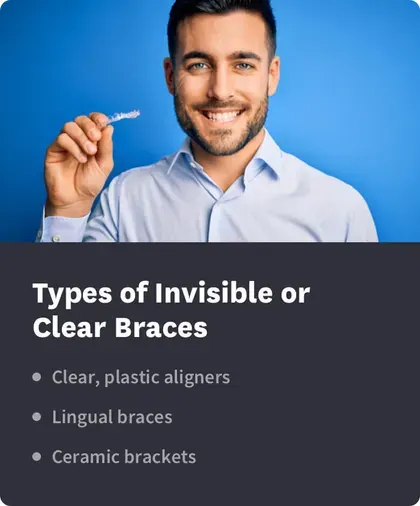Invisible Braces and Aligners: Types & Comparisons

Table of Contents
- Invisible Braces & Clear Aligners
- Benefits
- Costs
- Top Brands
- How Do They Work?
- Aligners vs. Braces
- Frequently Asked Questions
Today, there are many clear aligners, and clear and lingual braces to choose from including clear removable aligners, clear (ceramic) braces, and lingual braces.
What are Invisible Braces & Clear Aligners?

Invisible braces and clear aligners are designed to be virtually invisible when worn because they are made of a clear or tooth-colored material or because of their placement on the back of teeth.
How do invisible braces & aligners work?
Your teeth feel solid and rooted in your jaw. However, they can be moved via gentle pressure. Both braces and aligners take advantage of this characteristic.
When orthodontists apply gentle pressure (via braces or aligners) the bone attaching the tooth to the jaw remodels to allow the tooth to move. As bone breaks down and new tissues build up, the tooth shifts position and becomes rooted in place.
Moving teeth takes time, and the speed is variable. In a study of 11 people using aligners, tooth movement varied substantially, even though they were using the same devices for the same period.
How is this gentle pressure applied? That’s what makes braces and aligners different.
When many people think of braces, they may think of “traditional” metal braces, which consist of (quite noticeable) metal hardware, including metal brackets and wires. These traditional braces move teeth into place.
Brackets are attached to your teeth and connected by bands. An adjustable arch wire runs through these brackets and bands, and it is tightened (through orthodontist adjustments) in order to move teeth as needed. Most patients wear braces for 1 to 3 years.
These same principles are used with ceramic (clear) braces and lingual braces, although for lingual braces, the brackets and other hardware are applied to the back of teeth.
Clear aligners work differently. Clear teeth aligners are custom-designed for your mouth. They fit over your teeth. Each tray has subtle changes and pressure points to guide teeth to where they need to go.
You’ll progress from one aligner tray to the next, through your route to a corrected smile, until your treatment is complete. The average treatment time for clear aligners is 6 months.
Benefits of Invisible Braces & Clear Aligners
For those who don’t want their day-to-day appearance impacted by metal braces, the benefits of invisible braces and aligners are “clear” — they offer a less noticeable alternative for orthodontic treatment.
Clear aligners offer many benefits over even invisible braces, including these:
Flexibility: Unlike braces, clear aligners are removable. While they must be worn as prescribed to work properly, they can easily be taken out, so they don’t interfere with daily tasks like eating, high-impact sports or activity, or brushing or flossing your teeth.
Convenience: Braces require in-office orthodontist visits and adjustments. Many aligner providers offer virtual check-ins throughout orthodontist-supervised treatment. Some, like Byte, offer a completely mail-order experience that begins with an easy and refundable at-home impression kit to see if you’re a candidate for aligner treatment.
Fast treatment: Depending on how complex your orthodontic problem is, braces can take a year or more. Aligners have an average treatment time of around 6 months. Some providers offer helpful tools and may have an even shorter average treatment time.Byte, for example, includes a high-frequency massage tool HyperByte in each of our aligner kits. These types of accessories have been shown in research to help with comfort and results. Byte’s average treatment time is 4 months.
Costs
The costs will vary by which type of orthodontic treatment you choose.
Many insurance plans may cover some or all of the costs of aligners. Some aligner providers will help you through the insurance process or work with your insurance company directly.
Clear Aligners vs. Clear or Lingual Braces
| Ceramic braces | Lingual braces | Clear aligners | |
|---|---|---|---|
| visibility | clear or tooth-colored hardware | applied to the back of teeth; not visible from front | clear and fit over teeth |
| how they work | traditional bracket, band, and arch wire design | traditional bracket, band, and arch wire design | gradually move teeth with a series of aligner trays |
| average treatment time (approximate) | 1–3 years | 1–3 years | 6 months |
| convenience | fixed (not removable) – must be applied and adjusted in-office | fixed (not removable) – must be applied and adjusted in-office; may require additional adjustment time | can easily be removed; does not require in-office adjustments; some providers offer virtual check-ups or a 100% remote treatment with virtual monitoring and clinical staff access |
| cost | $4,000–$8,000 | $6,000–$10,000 | at home aligners range from $900-$2,500; in-office aligner prices vary but may cost up to $8,000 |
| insurance | many dental insurance plans will cover some or all of the cost of ceramic braces if they are correcting an orthodontic issue | dental plans may not cover the additional costs for lingual braces | dental plans may provide coverage for clear aligners if they are addressing an orthodontic issue; some aligner companies will assist you through the insurance process |
| benefits | less visible than traditional braces; may be covered by insurance | virtually invisible; more dentist visits may be appealing to those seeking more care | clear and removable; fast results; options for 100% remote treatment |
| disadvantages | prone to breakage and staining; requires in-office adjustments | expensive; may take longer to get used to wearing and require more adjustments | must be worn as advised (usually over 20 hours a day) in order to correct teeth |
Ceramic braces are much like traditional braces. Brackets are glued to the front of your teeth, and they’re connected by wires. Those wires are adjusted periodically in in-person appointments. Unlike traditional versions, these brackets are made of ceramic, so they’re not bright and shiny like traditional braces.
For some people, the reduced visibility of ceramic brackets make this type of device very attractive. And since ceramic braces work much like traditional versions, they can be used to treat even complex cases of orthodontic problems.
However, ceramic braces are more expensive than traditional versions. They can also be prone to chipping your existing teeth, and if you drink plenty of beverages like wine and coffee, they can be stained and become very visible.
Lingual braces are also similar to traditional braces. Brackets are glued to teeth and connected by wires. However, in a lingual system, the brackets are glued to the back of the teeth and not the front. Since these devices sit behind your teeth, they are virtually invisible.
For some people, the invisibility of lingual braces make them very attractive. However, they cost more than traditional braces. In addition, since these braces are more difficult to touch, adjustment appointments tend to take longer.
While all types of braces can be uncomfortable, lingual braces can cut the tongue and harm the soft tissues inside the mouth. They can also make speaking difficult, but you might adjust in time.
Clear aligners are very different than braces. Nothing is glued to your teeth, and no metal is required. Instead, clear plastic trays cover the entirety of your teeth. The trays are changed periodically to adjust the pressure.
Clear aligners make cleaning your teeth easy, as you can remove the trays to brush and floss. Since aligners are smooth, they can also cause less pain than the other devices we’ve mentioned. They can also be less expensive than traditional orthodontic devices.
While clear aligners come with plenty of advantages, they aren’t right for everyone. They may not be right for people with significant dental problems. Cases that are more than moderately difficult may be better treated with braces instead.
Invisible Braces & Clear Aligners: Top Brands
Ceramic and lingual braces are provided and chosen by your orthodontist. Clear aligners allow for more choice.
There are many aligner brands on the market, including these:
Invisalign offers clear aligners through licensed in-office orthodontic providers. Treatment starts with a consultation with a doctor who specializes in Invisalign. You’ll come into the office for check-ins and to pick up aligners.
Invisalign costs vary depending on the provider, but they start at around $3,500. Billing and financing must be worked out with the orthodontist.
Invisalign is a recognizable name in clear aligners, as they helped to popularize clear orthodontics. Today, however, there may be more convenient and affordable options on the market.
Byte is one of the highest-rated clear aligner companies on the market and also one of the most convenient. With an at-home impression kit, a user-friendly website and app, and orthodontic clinical staff available as needed, Byte makes it possible to correct your smile and bite completely from the comfort of your own home. We are also one of the fastest options available, with an average treatment time of 4 months.
Byte’s All-Day Aligner System costs $2,199. This includes all needed aligners for treatment, a high-frequency HyperByte massage tool (devices like this have been shown to improve treatment results and comfort), premium whitening paste, access to the Byte mobile app, and your first retainer.
Affordable and straightforward payment plans are also available.
Candid used to offer direct-to-consumer clear aligners but now offers their aligners through a hybrid model. You begin treatment with an in-office tooth scan and then remotely check in throughout treatment.
Because Candid no longer deals directly with consumers, pricing will vary depending on the orthodontist providing Candid. Online, some candid providers provide an average cost estimate of around $2,500 for treatment.
ALIGNERCO offers at-home aligners. After returning your impression kit, you’ll receive a Smile Projection (a 3D proposed treatment plan) in 12 to 14 days. If you opt to continue treatment, your aligners will be sent to you.
ALIGNERCO is one of the most affordable aligner providers on the market. Their aligner kit costs $1,145, and financing is also available.
ALIGNERCO may also offer less in terms of treatment support. Rather than an app or designated clinician, their site claims to provide customers with a “Smile Crew Member” who will act as a liaison between you and a dentist. You may be unable to speak directly to a dentist about your treatment.
Frequently asked questions
Your dentist or orthodontist can help you understand which type of dental device is right for you. In general, if your condition is mild to moderate, aligners could be a good choice. If your problems are more severe, you may benefit from braces instead.
Your dental professional can help you understand how these devices work and help to guide your treatment. When these devices are used under the care of a professional, they’re very safe.
The best way to keep your treatment on track is to follow your doctor’s instructions carefully. Don’t miss appointments, wear your aligner trays all the time, and keep your teeth as clean as you can.
